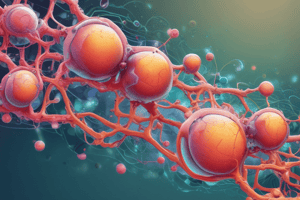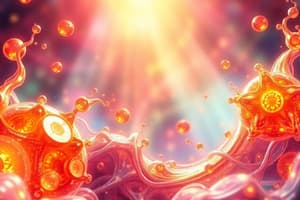Podcast
Questions and Answers
What is the first step in the mechanism of lipid oxidation?
What is the first step in the mechanism of lipid oxidation?
- Propagation
- Initiation (correct)
- Oxidation
- Termination
Which of the following initiators is most notable in living cells for lipid peroxidation?
Which of the following initiators is most notable in living cells for lipid peroxidation?
- Carbon dioxide
- Hydrogen gas
- Lithium ions
- Reactive oxygen species (ROS) (correct)
During the propagation phase, what does the lipid radical combine with to form a lipid peroxyl radical?
During the propagation phase, what does the lipid radical combine with to form a lipid peroxyl radical?
- Water
- Carbon monoxide
- Nitrogen gas
- Oxygen molecule (correct)
What occurs during the termination phase of lipid oxidation?
What occurs during the termination phase of lipid oxidation?
Which of the following is NOT a biomedical consequence of lipid peroxidation?
Which of the following is NOT a biomedical consequence of lipid peroxidation?
What is the role of antioxidants in lipid peroxidation?
What is the role of antioxidants in lipid peroxidation?
What is produced when two radicals react during lipid oxidation?
What is produced when two radicals react during lipid oxidation?
What describes the overall mechanism of lipid oxidation?
What describes the overall mechanism of lipid oxidation?
Which antioxidant is responsible for decomposing hydrogen peroxide into water and oxygen?
Which antioxidant is responsible for decomposing hydrogen peroxide into water and oxygen?
Which vitamins listed are known for their antioxidant activity?
Which vitamins listed are known for their antioxidant activity?
What minerals are required for the activity of superoxide dismutase?
What minerals are required for the activity of superoxide dismutase?
Which reactive species is associated with both vitamin E and vitamin C as antioxidants?
Which reactive species is associated with both vitamin E and vitamin C as antioxidants?
What is the primary role of catalase in the antioxidant defense system?
What is the primary role of catalase in the antioxidant defense system?
Which vitamin is considered the most effective naturally occurring chain-breaking antioxidant in tissues?
Which vitamin is considered the most effective naturally occurring chain-breaking antioxidant in tissues?
What is the primary role of preventive antioxidants?
What is the primary role of preventive antioxidants?
Which of the following antioxidants acts in the aqueous phase?
Which of the following antioxidants acts in the aqueous phase?
How does Alpha Tocopherol (Vitamin E) deactivate a peroxyl free radical?
How does Alpha Tocopherol (Vitamin E) deactivate a peroxyl free radical?
Which of the following substances is classified as a mineral antioxidant?
Which of the following substances is classified as a mineral antioxidant?
Which type of antioxidant system is primarily geared towards utilizing enzymes?
Which type of antioxidant system is primarily geared towards utilizing enzymes?
What type of antioxidant is Butylated Hydroxyanisole (BHA)?
What type of antioxidant is Butylated Hydroxyanisole (BHA)?
Which of the following is an example of a chain-breaking antioxidant?
Which of the following is an example of a chain-breaking antioxidant?
Study Notes
Lipid Peroxidation Mechanism
- Lipid peroxidation is a chain reaction that occurs in three phases: initiation, propagation, and termination.
- Initiation involves the formation of a fatty acid radical through the reaction of a reactive oxygen species (ROS), such as hydroxyl radical (OH), with a fatty acid.
- Propagation occurs when the unstable fatty acid radical reacts with oxygen to form a peroxyl-fatty acid radical, which then reacts with another fatty acid, perpetuating the cycle.
- Termination happens when two radicals react, forming a non-radical species, ending the chain reaction.
Biomedical Importance
- Lipid peroxidation plays a significant role in various biological processes, both beneficial and detrimental.
- It contributes to the deterioration of foods (rancidity), a process known as oxidative rancidity.
- It is implicated in the development of chronic diseases like cancer, inflammatory diseases, atherosclerosis, and aging.
Antioxidants
- Antioxidants are crucial in regulating and minimizing lipid peroxidation.
- They act as food additives and are found naturally in various foods.
Types of Antioxidants
- Antioxidants Used as Food Additives:
- Propyl gallate
- Butylated hydroxyanisole (BHA)
- Butylated hydroxytoluene (BHT)
- Naturally Occurring Antioxidants:
- Vitamin E (tocopherol)
- Vitamin C
- Urate
- Beta-carotene
Alpha Tocopherol (Vitamin E)
- Vitamin E, specifically alpha tocopherol, acts as a potent chain-breaking antioxidant by intercepting peroxyl free radicals, preventing them from attacking polyunsaturated fatty acids (PUFAs).
- Vitamin E is a lipid-soluble antioxidant, while vitamin C is water-soluble.
- Ceruloplasmin, a protein found in extracellular fluid, can also act as an antioxidant.
- Other minor antioxidants include caffeine, cysteine, glutathione, and vitamin A (beta-carotene).
Antioxidant Classes
- Preventive Antioxidants:
- They reduce the rate of chain initiation.
- They include:
- Catalase
- Glutathione peroxidase
- Selenium
- Chelators of metal ions (e.g., EDTA, DTPA)
- Chain-breaking Antioxidants:
- They interfere with chain propagation.
- They include:
- Superoxide dismutase (acts in the aqueous phase)
- Urate (acts in the lipid phase)
- Vitamin E (acts in the lipid phase)
Types of Antioxidant Systems
- There are three main types of antioxidant systems:
- Enzymes antioxidant system
- Vitamins antioxidant system
- Minerals antioxidant system
Enzymes Antioxidant System
- This system comprises three enzymes:
- Superoxide dismutase (SOD)
- Catalase
- Glutathione peroxidase
- These enzymes work to neutralize superoxide radicals and hydrogen peroxide.
Superoxide dismutase (SOD)
- SOD catalyzes the conversion of the highly reactive superoxide radical (O2−O_2^-O2−) into less toxic hydrogen peroxide.
Catalase
- Catalase scavenges the hydrogen peroxide generated by SOD by decomposing it into water and oxygen.
Vitamins Antioxidant System
- Vitamins with antioxidant activity include:
- Tocopherol (Vitamin E)
- B-carotenes (vitamin A)
- Ascorbic acid (vitamin C)
- These vitamins help reduce and detoxify oxygen intermediates within cells.
Minerals Antioxidant System
- The functionality of antioxidant enzymes relies on the availability of essential minerals:
- Manganese
- Copper
- Zinc
- Selenium
- These minerals are crucial for the activity of superoxide dismutase and glutathione peroxidase.
Studying That Suits You
Use AI to generate personalized quizzes and flashcards to suit your learning preferences.
Related Documents
Description
This quiz explores the mechanisms of lipid peroxidation, including its phases of initiation, propagation, and termination. Additionally, it highlights the biomedical importance of lipid peroxidation in food deterioration and chronic diseases. Test your knowledge on this crucial topic in biochemistry and health.




